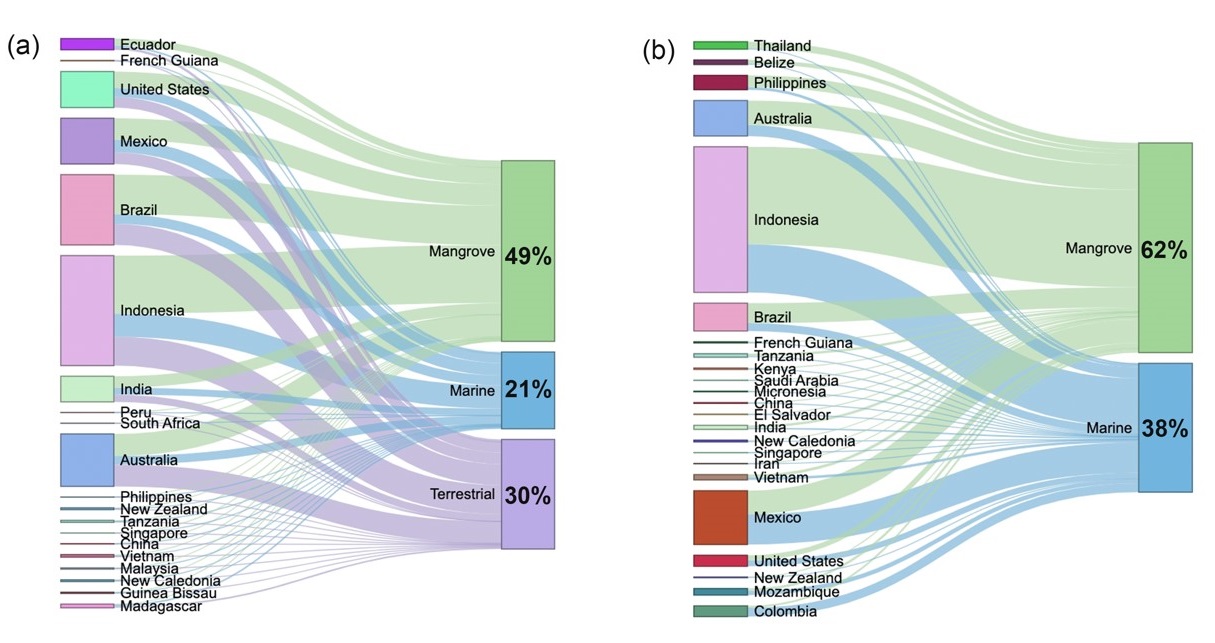Researchers Investigate Organic Carbon Sources in Mangrove Sediments
Mangrove forests are one of the most productive blue carbon ecosystems (BCEs), offering a range of ecosystem services including fisheries production, coastal protection, sediment fixation, and notably, carbon sequestration. Mangrove sediments hold approximately 70% of the whole ecosystem carbon (C) storage, varying in magnitude geographically, which is primarily determined by coastal environmental settings (CES, such as estuarine and marine mangroves).
Blue C ecosystems not only sequester atmospheric carbon dioxide (CO2) through biogenic processes but also serve as repositories for C transported from external sources. Mangrove sediments, in particular, accumulate both allochthonous organic carbon (OC) from marine or terrestrial origins, facilitated by tidal exchanges, and autochthonous OC derived from mangrove vegetation. Accurate quantification of these OC fractions is essential for the proper allocation of C credits under certification standards such as the Verified Carbon Standard (VCS) methodology (VM0033).
Researchers from the Coastal Zone Ecosystem Processes and Environmental Health Research Group at the South China Botanical Garden, Chinese Academy of Sciences, conducted global-scale analysis of the provenance of soil organic carbon (SOC) sources in mangroves. They incorporate a comprehensive dataset of stable isotope signatures, nitrogen to carbon ration (N/C) values and SOC of mangrove sediments, along with relevant environmental and socioeconomic information, including the proximity of mangroves to rivers. They identified the sources of OC, compared SOC stocks between estuarine and marine mangroves and employed machine learning algorithms to explore the primary factors influencing SOC sources in mangroves.
Globally, mangrove-derived autochthonous OC was the main contributor to estuarine and marine mangrove top-meter soil organic carbon (SOC) (49% and 62%, respectively). Less marine allochthonous OC (21%) was deposited than terrestrial allochthonous OC (30%) in estuarine mangrove sediments. Estuarine mangroves accumulated more SOC in sediments than marine mangroves (282 ± 8.1 Mg C ha-1 and 250 ± 5 Mg C ha-1, respectively), primarily due to the additional terrestrial OC inputs. Globally, marine mangroves held 67% of the total mangrove SOC, reaching 3025 ± 345 Tg C, while 1502 ± 154 Tg C was stored in estuarine mangrove sediments. The findings emphasize the substantial influence of coastal environmental settings on OC contributions, underlining the necessity of accurate OC source quantification for the effective allocation of blue carbon credits.
The research findings were published online in Nature Communications (https://doi.org/). Jingfan Zhang, a doctoral student from the Coastal Zone Ecosystem Processes and Environmental Health Research Group at the South China Botanical Garden, is the first author of the paper. At the same time, Professor Faming Wang, the head of the research group and director of the Xiaoliang Station, is the corresponding author.

Figure 1. Relative contributions of organic carbon (OC) sources to estuarine and marine mangrove sediment OC.
File Download: